Defining
the Inuit Dog
Canis familiaris borealis
by Sue Hamilton
Canis familiaris borealis
by Sue Hamilton
© December 2011, The
Fan Hitch, all rights reserved
revised: December 2020
revised: December 2020
A.
The Inuit Dog’s place in the natural world
B. The Inuit Dog is not a wolf!
C. Dangerous confusion
B. The Inuit Dog is not a wolf!
C. Dangerous confusion
A. The Name Controversy
B. Defining 'Purity'
C. Mistaken Identity: Promoting a breed vs. avoiding
extinction
D. The Belyaev Experiment
E. Summary
B. Defining 'Purity'
C. Mistaken Identity: Promoting a breed vs. avoiding
extinction
D. The Belyaev Experiment
E. Summary
A. Ancient
history
B. Recent history: The Inuit Dog in service to nations
B. Recent history: The Inuit Dog in service to nations
1. Exploration
2. War
3. Sovereignty
2. War
3. Sovereignty
C.
Population decline
A. In the North
B. Below the tree line
B. Below the tree line
A.
Inherited diseases
B. Disease prevention and access to veterinary services
B. Disease prevention and access to veterinary services
A.
Appearance
B. Behavior
C. Performance
D. The big picture
VII. The Inuit Dog in
Scientific Research, Films andB. Behavior
C. Performance
D. The big picture
in Print
VIII. Acknowledgements
Appendix 1: Partial list of scientific publications about
the Inuit Dog
Appendix 2: Selected (alphabetical) list of other resources
with a focus on Inuit Dogs
Appendix 3: A small sampling of other resources of
interest
Navigating This Site
Index of articles by subject
Index of back issues by volume number
Search The Fan Hitch
Articles to download and print
Defining the Inuit Dog
Ordering Ken MacRury's Thesis
Our comprehensive list of resources
About The Fan Hitch
Talk to The Fan Hitch
The Fan Hitch home page
Editor-in-Chief: Sue Hamilton
Webmaster: Mark Hamilton
The Fan Hitch,
Journal of the Inuit Sled Dog, is published
four times a year. It is available at no
cost online at: https://thefanhitch.org.
The Fan Hitch welcomes your letters, stories, comments and suggestions. The editorial staff reserves the right to edit submissions used for publication.
Contents of The Fan Hitch are protected by international copyright laws. No photo, drawing or text may be reproduced in any form without written consent. Webmasters please note: written consent is necessary before linking this site to yours! Please forward requests to Sue Hamilton, 55 Town Line Rd., Harwinton, Connecticut 06791, USA or mail@thefanhitch.org
This site is dedicated to the Inuit Dog as well as related Inuit culture and traditions. It is also home to The Fan Hitch, Journal of the Inuit Sled Dog.
The Fan Hitch welcomes your letters, stories, comments and suggestions. The editorial staff reserves the right to edit submissions used for publication.
Contents of The Fan Hitch are protected by international copyright laws. No photo, drawing or text may be reproduced in any form without written consent. Webmasters please note: written consent is necessary before linking this site to yours! Please forward requests to Sue Hamilton, 55 Town Line Rd., Harwinton, Connecticut 06791, USA or mail@thefanhitch.org
This site is dedicated to the Inuit Dog as well as related Inuit culture and traditions. It is also home to The Fan Hitch, Journal of the Inuit Sled Dog.
Although he lives below the tree line, sledding through the Skarvheimen Mountains
of Norway still offers Gisle Uren and his Greenland Dogs a polar landscape perfect
for arctic expedition training.
Photo: Jens Otto Nørbech-Eidem
II. Nomenclature,
Genetics and Identity
A. The name controversy
There is confusion regarding
terminology. Questions often asked are, “What is the
difference between a Canadian Inuit Dog and a Canadian
Eskimo Dog (CED)?” “Are they different from a Greenland
Dog?” “What is an Inuit Sled Dog?”
The name "Eskimo" is a corruption of a name assigned by non-Inuit more than a century ago. It has long since been considered pejorative, and the name was almost entirely abandoned at the time of the first Inuit Circumpolar Conference held in Barrow, Alaska in 1977 when "Inuit", meaning The People, was officially adopted. Honoring the desire to be identified as "Inuit" is not an issue of political correctness, but a matter of respecting the wishes of those who prefer to be called by a name of their own choosing, not one assigned to them by another culture. However, the term "Eskimo" is still used in an historic sense. And it is appropriate to identify Alaskan Yupik/Aleut as "Eskimo". The word is also used in the world of cultured all breed kennel club registered dogs, including the Canadian Kennel Club (CKC) who registers both the CED and the Greenland Dog (The CKC offers a massively confusing description of the Greenland Dog as follows: “Since the Inuit people of Canada’s Arctic were known to have emigrated from Greenland many centuries ago bringing their sled dogs with them, it’s possible this hardy polar Spitz breed is the forerunner of our native Canadian Eskimo Dog.”), The Kennel Club (Great Britain) who registers separately a CED and a Greenland Dog (calling it native to Greenland), and the Fédération Cynologique Internationale (FCI) who separately recognizes the CED and the Greenland Dog (Greenland listed as country of origin).
The policy of kennel clubs registering "Canadian Eskimo Dogs" and "Greenland Dogs" instead of identifying them as "Inuit Dogs" is an artificial contrivance, not based on the scientifically proven reality that the aboriginal Canadian Inuit Dog and the aboriginal Greenland Dog are indeed the same landrace. In his 1991 masters thesis, The Inuit Dog: Its Provenance, Environment and History, MacRury describes the Inuit Dog as one landrace that was found from Alaska to Greenland, based on the migration pattern of ancient Inuit ancestors and archaeological findings at early living sites. This was later confirmed for the first time ever by DNA analysis. In her Veterinary Masters Thesis, Dr. Hanne Friis Andersen states, "…there is no genetic evidence that states the presence of two different dog breeds in the native Arctic. From a geneticist’s point of view, based on this study the Canadian Inuit dog and Greenland dog is one breed divided into subpopulations."1
The name "Eskimo" is a corruption of a name assigned by non-Inuit more than a century ago. It has long since been considered pejorative, and the name was almost entirely abandoned at the time of the first Inuit Circumpolar Conference held in Barrow, Alaska in 1977 when "Inuit", meaning The People, was officially adopted. Honoring the desire to be identified as "Inuit" is not an issue of political correctness, but a matter of respecting the wishes of those who prefer to be called by a name of their own choosing, not one assigned to them by another culture. However, the term "Eskimo" is still used in an historic sense. And it is appropriate to identify Alaskan Yupik/Aleut as "Eskimo". The word is also used in the world of cultured all breed kennel club registered dogs, including the Canadian Kennel Club (CKC) who registers both the CED and the Greenland Dog (The CKC offers a massively confusing description of the Greenland Dog as follows: “Since the Inuit people of Canada’s Arctic were known to have emigrated from Greenland many centuries ago bringing their sled dogs with them, it’s possible this hardy polar Spitz breed is the forerunner of our native Canadian Eskimo Dog.”), The Kennel Club (Great Britain) who registers separately a CED and a Greenland Dog (calling it native to Greenland), and the Fédération Cynologique Internationale (FCI) who separately recognizes the CED and the Greenland Dog (Greenland listed as country of origin).
The policy of kennel clubs registering "Canadian Eskimo Dogs" and "Greenland Dogs" instead of identifying them as "Inuit Dogs" is an artificial contrivance, not based on the scientifically proven reality that the aboriginal Canadian Inuit Dog and the aboriginal Greenland Dog are indeed the same landrace. In his 1991 masters thesis, The Inuit Dog: Its Provenance, Environment and History, MacRury describes the Inuit Dog as one landrace that was found from Alaska to Greenland, based on the migration pattern of ancient Inuit ancestors and archaeological findings at early living sites. This was later confirmed for the first time ever by DNA analysis. In her Veterinary Masters Thesis, Dr. Hanne Friis Andersen states, "…there is no genetic evidence that states the presence of two different dog breeds in the native Arctic. From a geneticist’s point of view, based on this study the Canadian Inuit dog and Greenland dog is one breed divided into subpopulations."1

|
Inuit Dogs
in the Baffin Region |
Inuit Dogs
in Sermiligaaq, East
|
In 1990s era issues of the Canadian Eskimo Dog Gazette mention was made of Canadian Eskimo Dog Association (CEDA) members discussing voting to change the name to Canadian Inuit Dog and then petitioning the CKC to make the change official. That proposal seemed to have died away. Recently however, here and there on websites fanciers of dogs for show and pet now identify their animals as "Canadian Eskimo/Inuit Dogs" or "CED/CID". And there has once again appeared a movement to petition kennel club registries to change the official name. Trying to understand why this is happening would be merely speculative. Changing the name, officially or otherwise, of the kennel club registered (or hope to be registered) dog from "Canadian Eskimo Dog" to "Canadian Inuit Dog" or whatever would be like a sleight-of-hand deception. Owner/breeders could hide their "cultured" dogs bred to show and pet standards behind the true aboriginal dog that can actually perform as their ancestors have done. The distinctions between what the aboriginal Canadian Inuit Dog represents and can do and what the kennel club registered Canadian Eskimo Dog represents but cannot do should be defined at least in part by their different labels.
B. Defining 'purity'
The question has also been
asked, "Is an Inuit Dog a pure breed?" To those wedded to
the world of all-breed kennel club registered dogs, purity
is defined as a multi-generational pedigree consecrated by
an official club registration number. Others who
understand and respect the nature of aboriginal landrace
dogs know that:
Having traveled extensively throughout the Canadian Arctic, Bill Carpenter and John McGrath were alarmed by the dwindling numbers of traditional dogs seen. In the early 1970s they established the Eskimo Dog Recovery Project. The two men collected examples of dogs from working teams across the Arctic and bred them at Carpenter's kennel in Yellowknife, Northwest Territories, Canada. The endeavor was a success in that it resulted in a revitalized number of these aboriginal dogs. In order to "validate" their work, those animals were registered with the Canadian Kennel Club.3 Some of the Recovery Project dogs were placed with breeders who lived in the Arctic and elsewhere below the tree line who reproduced and used them strictly as working dogs. And it is from those sources that represent some but not all of the today's authentic traditional stock remaining in the Arctic, now identified as Inuit Dogs or Inuit Sled Dogs. Other dogs from the Recovery Project were taken up by the Canadian Kennel Club dog show and pet fancy. This was an unintended consequence, at least according to Carpenter and McGrath. Eschewing the world of show dogs and pets, Carpenter said in a January 31, 2001 New York Times interview:
"The word "purebred" is an invention of the modern dog world. Due to environmental isolation and survival of the fittest, landraces are pure."2This concept may be incomprehensible or at best poorly digested by average "cultured dog breed" pet owners and it is often vigorously rejected by breeders of show and pet dogs who insist that only dogs whose parentage can be listed on a validated pedigree form are "purebred." Yet at the same time these very people cling tightly to and advertise with great enthusiasm their romantic representation of an ancestral/authentic history (one lacking kennel club registries), despite their own dogs being diluted by time and change in habitat and the loss of traditional working skills during their conversion to show/pet lifestyles.
Having traveled extensively throughout the Canadian Arctic, Bill Carpenter and John McGrath were alarmed by the dwindling numbers of traditional dogs seen. In the early 1970s they established the Eskimo Dog Recovery Project. The two men collected examples of dogs from working teams across the Arctic and bred them at Carpenter's kennel in Yellowknife, Northwest Territories, Canada. The endeavor was a success in that it resulted in a revitalized number of these aboriginal dogs. In order to "validate" their work, those animals were registered with the Canadian Kennel Club.3 Some of the Recovery Project dogs were placed with breeders who lived in the Arctic and elsewhere below the tree line who reproduced and used them strictly as working dogs. And it is from those sources that represent some but not all of the today's authentic traditional stock remaining in the Arctic, now identified as Inuit Dogs or Inuit Sled Dogs. Other dogs from the Recovery Project were taken up by the Canadian Kennel Club dog show and pet fancy. This was an unintended consequence, at least according to Carpenter and McGrath. Eschewing the world of show dogs and pets, Carpenter said in a January 31, 2001 New York Times interview:
"The future of this dog is not with southern dog shows, not with pet owners on leashes. The future of this dog lies in its cultural setting. The future of the dog is in the hands of the northerners."Because some of these CKC registered dogs can be traced back to the Recovery Project does not mean that these are the only "pure" dogs remaining as has been claimed.4 It simply indicates that this is a population of dogs whose lineage is known back to the Recovery Project.
C.
Mistaken Identity: Promoting a breed vs. avoiding
extinction
Back in late 19th
century Victorian England the keeping, breeding and
creating of new breeds of dogs strictly as pets and
for competition at shows became hugely popular and
is acknowledged as the beginning of the end for the
functional skills of many working breeds.5 Yet
today naïve enthusiasts believe they can "save the
rare Eskimo Dog" by "promoting the breed" through
making and selling puppies, exhibiting at dog shows,
displaying cute photographs of their dogs and
children and racing their dogs for a few kilometers
in front of a wheeled cart or occasionally a sled.
As long as they are referring only to the registered
show/pet dog, they may (or may not) be correct.
However, as promoting in this manner is not
synonymous with avoiding extinction, they are wrong
in believing their dogs are the same as authentic
aboriginal dogs of Canada and Greenland.
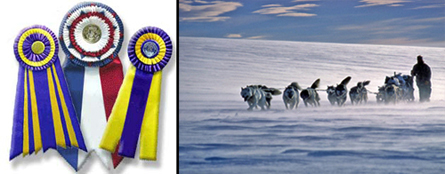
|
These are the prizes for winning a beauty contest. |
The prize
for good working dogs in an Antarctic ground
blizzard is you get to live. Photo: Drummond Small |
Enthusiasts of kennel club
registered dogs have also conducted a media campaign to
try to convince (and therefore have misled) the public
that their breed is endangered and in need of government
involvement in a rescue effort.6
Publically pleading their case, they cited a high point
population of some 20,000 dogs, which represents a figure
used by Inuit organizations as the population of
aboriginal dogs prior to 1950, down to a low point of 200
or so which represents the number of CKC registered dogs,
the real object of their lament – a comparison of apples
to oranges. While traceable back to the Eskimo Dog
Recovery Project, these dogs have been bred to a show
standard and as pets, not strict adherence to traditional
performance and challenged by the severe polar conditions
which selects for the most capable and heartiest stock.
This has impacted on the dogs' original identity.
Some mushers keeping other than these aboriginal dogs have sought to whittle away at the Inuit Dog's persona. It is their illogical belief that since the dog no longer needs to hunt polar bear, it no longer needs to retain its legendary Inuit Dog temperament (mistakenly assuming that the dog's temperament is solely a consequence of its hunting skills). This aspect of the Inuit Dog presents a management challenge for many sled dog keepers who either cannot or do not want to cope with this landrace.
Members of the non-mushing community also seek to chip away at the authentic Inuit Dog:
Some mushers keeping other than these aboriginal dogs have sought to whittle away at the Inuit Dog's persona. It is their illogical belief that since the dog no longer needs to hunt polar bear, it no longer needs to retain its legendary Inuit Dog temperament (mistakenly assuming that the dog's temperament is solely a consequence of its hunting skills). This aspect of the Inuit Dog presents a management challenge for many sled dog keepers who either cannot or do not want to cope with this landrace.
Members of the non-mushing community also seek to chip away at the authentic Inuit Dog:
"Nowadays not so much people need a [Canadian
Eskimo/Inuit] dog to pull a sled, so probably taking
them to shows or exhibitions, or, in general, spread the
word about them, might save them in the future…"7
This equally illogical
concept of "saving" a breed is actually what destroys it!
Champagne would not be champagne without the bubbles.
Lacking the effort to re-cork the bottle, the contents go
flat. Breeders cannot pick and choose characteristics that
fit in with their limited dog handling skills, their
lifestyles and of those to whom they hope to peddle their
puppies. Ignoring the characteristics that are hallmarks
of the Inuit Dog, will result in changes so profound that
the outcome is the creation of a different breed
altogether.
D. The Belyaev ExperimentBack in the mid-20th
century, Russian geneticist Dr. Dmitry Belyaev began a
groundbreaking experiment in an effort to study the
evolution of dog domestication. On a Siberian fur fox
farm, he bred only those animals with the least flight
distance from humans to see if they could be
tamed/domesticated. The results were startling. Aside from
an increasingly biddable dog-like behavior, the appearance
of a typical wild silver fox morphed to display features
found in domestic dogs: piebald coats, floppy ears, blue
eyes, curled tails. .8
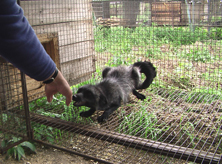 |
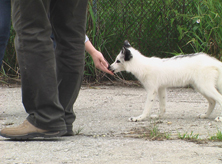 |
| Selection
based on behavior alone has resulted in the
dramatic change from terrified of human approach
and wild type coat color (left) to social
attraction and a piebald coat color pattern
right). |
These photos were taken in
Novosibirsk on the experimental farm of the
Institute of Cytology and Genetics of the
Siberian Branch of the Russian Academy
of Science. |
The lesson of what happens when selection is made on the basis of a behavior not native to the original animal is one that resonates with aboriginal dog enthusiasts, in this case Inuit Dogs. Misguided owner-breeders of kennel club registered Eskimo Dogs and Greenland Dogs are too intent on their mission to "save the breed" even if they cannot possibly (nor do they want to) duplicate the same environment and working conditions to honestly keep it from going extinct. What they refuse to accept, for any number of reasons, is that what they have in their back yards can be described as the equivalent of Belyaev's genetically (behaviorally) modified fur foxes. If someone wanted to wear a silver fox coat, it is not likely that they would think one that had blotches of color like a pinto horse could be considered authentic. Although not referring to a change in phenotype as seen in the side-by-side fox images above, reproduction of dogs not consistent with their traditional characteristics will mean a loss of the essential survival and working abilities, alterations not necessarily visible to the naked eye, but gone nonetheless.
Belyaev's work is a critical contribution to the argument that aboriginal dogs can only remain so by being challenged by climate and work as performed in their native habitats to remain as they have been for centuries, or even millennia..
E.
Summary
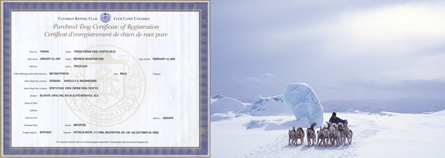
This paper presumably proves "purity." Purity proving itself in the work environment.
Photo: K. Suboch
The official CKC breed
standard makes no meaningful/useful mention of working
ability. While it lists faults and disqualifications, some
of which relate to what an authentic dog ought not look
like (albeit ignoring the natural range that one would
expect in an aboriginal landrace), there are no faults or
disqualifications relating to its actual capabilities.
| Pedigree (purity) alone without validation of performance does not confer breeding worthiness. The dogs must do more than "talk the talk" to truly be considered authentic. The dogs must prove they can "walk the walk". |
"It looks good on paper, Leonardo,
but will it
fly?"
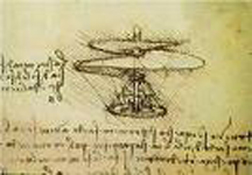
Leonardo DaVinci's vision of a helicopter,
also called the "ariel-screw"
In his thesis, MacRury
emphasizes the absolute need for performance based
breeding.9
He recounted the story of a Baffin Island community that
at one point had no working teams, then obtained from all
over the region a variety of dogs that neither performed
well nor "looked the part". But after four or five years
of intense selection and culling, the resulting dogs
exemplified the most authentic type in appearance,
behavior and capabilities10.
In a June 21, 1988 New
York Times interview eminent behavioral
geneticist, Dr. Benson E. Ginsburg, Professor Emeritus at
the University of Connecticut, Storrs, Connecticut, said,
"Genetic variability is
built into a species so it can adapt if conditions
change. In wild forms, the coyote and wolf, there are
what we call buffering systems so that genes they have
are not necessarily expressed. In domestication [here
referring to cultured breeds], the system of genes that
buffer differences from the norm are bred out.''
Dr. Ginsburg concluded, ''We
have selected away from the buffering system, so all
possibilities can appear, and dogs can freely show all
their genetic variability." It may have taken
four or five years for that Baffin Island community to
restore the Inuit Dog, but it is certain that it takes a
lot less time, perhaps a carelessly bred generation or
two, to destroy a landrace!
So the answer to the question, "Is the Canadian Inuit Dog/Greenland Dog/Inuit Sled Dog the same as the Canadian Eskimo Dog?" is both "yes" and "no". The two names are not interchangeable when one is comparing dogs bred based on their ability to thrive and work in their native habitat (Canadian Inuit Dog) and the other is being promoted, owned, kept and bred essentially as a cultured pet/show dog (Canadian Eskimo Dog)! The genetic origins may be the same but only through culling and selection based on arctic conditions and successful work may return the CED to being the dog of its predecessors. One thing is certain. The real endangered species is not the registered show dog, but the aboriginal landrace of the North.
1 Population Genetic Analyses of
the Greenland dog and Canadian Inuit dog, May 2005 by Dr.
Hanne Friis Andersen, Royal Veterinary and Agricultural
University, Frederiksberg, Denmark.So the answer to the question, "Is the Canadian Inuit Dog/Greenland Dog/Inuit Sled Dog the same as the Canadian Eskimo Dog?" is both "yes" and "no". The two names are not interchangeable when one is comparing dogs bred based on their ability to thrive and work in their native habitat (Canadian Inuit Dog) and the other is being promoted, owned, kept and bred essentially as a cultured pet/show dog (Canadian Eskimo Dog)! The genetic origins may be the same but only through culling and selection based on arctic conditions and successful work may return the CED to being the dog of its predecessors. One thing is certain. The real endangered species is not the registered show dog, but the aboriginal landrace of the North.
2 ”Breed, Landrace and Purity: What do they mean?” by Edith and Johan Gallant, The Fan Hitch Journal, V13, N1; December 2010
3 The Canadian Eskimo Dog had already been registered by both the Canadian and American Kennel Clubs, the latter decertifying the breed sometime in the 1950s due to lack of sufficient numbers.
4 From a July 2002 sled dog email discussion list, “…the Canadian Eskimo Dog Association of Canada which is an international group. Please do not feel it necessary to be "P.C" [politically correct] and change the name as the dogs are officially recognized by the CKC as well as the Ministry of Agriculture as the above name. As an aside - "inuit dogs" refer to a crossbred version of our dogs, as well as one Canadian version of the alaskan version - gets very confusing. Thanks.” N.D. Nicole Doyon, Secretary/Photographer - Canadian Eskimo Dog Association of Canada.”
5 Dogs That Changed the World;
Evolutionary Changes In Domesticated Dogs: The Broken Covenant Of The Wild, Part 1 and Part 3 - Cultured Breeds and Show-Pet Dogs.
6 See: The Games People Play: Save the Sled Dog or Save the Show Dog, The Fan Hitch, V6N2, March 2004
7 Debora Segna, personal communication, April 2012.
8 How to Tame a Fox: (and Build a Dog) Visionary Scientists and a Siberian Tale of Jump-Started Evolution by Lee Alan Dugatkin and Lyudmila Trut
9 The Inuit Dog: Its Provenance, Environment and History; Ian Kenneth MacRury. Chapter 1, pg 5, pp 3.
10 Personal communication.